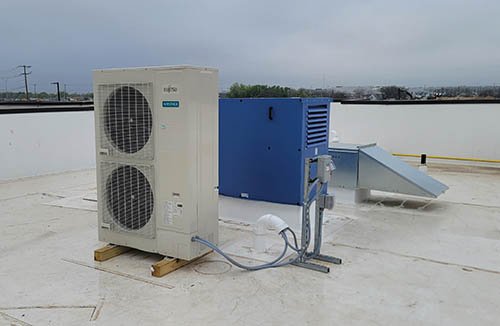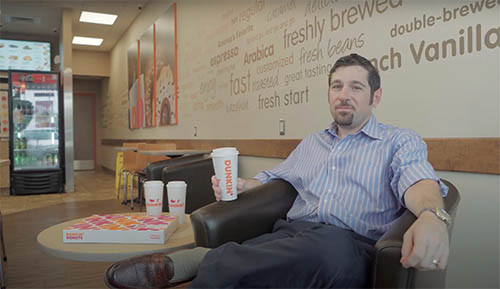— By Sean-Paul Ferrera —
The promise of energy efficiency for restaurant franchises.
Today’s restaurant operators face a whole host of challenges, from increased competition and a tight labor market to rising commodity (i.e. food, packaging or cutlery) and energy prices. As a result of constantly juggling these contending pressures, owners have to carefully evaluate where they spend their time and money to ensure both happy customers and profitable margins.

For restaurant owners, sustainability has traditionally taken a backseat to these more tangible day-to-day concerns, but ultimately, this amounts to a missed opportunity. Running a sustainable operation isn’t just good for a restaurant’s bottom line, it can also significantly enhance the customer experience. And as sustainability has become a more mainstream part of modern business, there are now ways that restaurant owners can go green without the headache, most notably by outsourcing new energy consuming equipment upgrades to specialized teams that know how to lower their total operating costs.
The Heavy Energy Footprint of the Restaurant Industry
It might be obvious, but it’s worth repeating: restaurants use a lot of energy, whether for refrigeration, HVAC, cooking, lighting, POS or anything else. With the annual cost of electricity netting out at around $7.50 per square foot of restaurant space, utility bills have a sizable impact on operating budgets. Aside from fronting the cash to invest in efficient upgrades, there’s little restaurants can do to reduce electricity consumption, as equipment can’t simply be turned off during working hours. This inflexibility renders restaurants vulnerable to price volatility in electricity markets, which remains a chief concern for many owners today. In just the last year alone, prices are up 15%, posing fundamental challenges to an industry that gets by on an average profit margin of just 3-5%.
Where Traditional Energy Management Models Fall Short
To remain competitive and meet the evolving demands of consumers, restaurants are increasingly looking to become more energy-efficient. Unfortunately, there are often high barriers to adoption and limited choices that fit our spaces. Even for the most sustainably conscious owners, the price to purchase the necessary technologies are a non-starter. During the best of times, it can be difficult for the restaurant business to turn a profit, so equipment upgrades that require a high CapEx are simply unrealistic for most. Those that can afford the upgrades, on the other hand, tend to run into problems navigating complex utility and regulatory markets and struggle to extract the greatest financial benefits that energy-efficient technologies have to offer. The number of potential equipment upgrades available to restaurants grows daily, so what’s key is knowing where the biggest bang for your buck lies. Unfortunately, this information isn’t easy to come by. Without the proper tools and expertise, the best that restaurant owners can do is haphazardly fathom a guess as to what equipment needs to be replaced. Ultimately, this is like trying to find the proverbial needle in a haystack — the results may not justify the time.
Ownership of new, high-efficiency equipment also comes with added risk and liability, and saddles businesses with the responsibility of performing proper maintenance. Traditional energy management models that offer short term contracts are not suited to deliver fast-casual and quick-service restaurants’ needs, which in turn have been slow to adopt efficient and sustainable upgrades. What operators need, rather, is a partner that takes on energy needs lock, stock and barrel. With a new way of embracing energy efficiency emerging, however, this is beginning to change — much to the benefit of restaurant owners, consumers and the environment as a whole.
A Dunkin’ Success Story
Energy as a Service (EaaS) providers now allow restaurant owners to outsource efficiency upgrades in a much easier and more cost-effective process. Equipped with extensive industry expertise, these companies are able to pinpoint exactly what upgrades are needed the most, translating into optimized savings for the long haul. And as EaaS providers are integrated partners, they absorb much — if not all — of the up-front costs of equipment upgrades, making them a reliable option for restaurants looking to cut utility bills without taking on bloated cost burdens.
When done right, energy efficiency offers more than just dollars saved and emissions reduced — it can also boost the comfort of indoor dining spaces. Plus, it can have a positive impact on air quality and morale, improve food preparation safety and even help alleviate stress on the grid on the hottest days of the year.

As a franchisee and member of the Dunkin’ Brands, now Inspire Brands, sustainability subcommittee, I’ve seen firsthand the benefits one can reap from energy efficiency. Leveraging our EaaS provider, Budderfly, we’ve transformed our energy footprint across six unique spaces with new lighting, remote sensing, energy usage monitoring and, most importantly, heat pump-powered ultra-high-efficiency HVAC systems. Since installation, we’ve seen a net ~60% performance increase, all while reducing necessary ductwork and slashing utility costs and emissions. To top this off, Budderfly’s innovative HVAC has helped stabilize internal air temperatures and reduce humidity, leading to bakery products that stay fresh for longer. That’s right — energy efficiency makes better-tasting donuts!
Outsourcing these upgrades to our EaaS provider has allowed us to reap the benefits of energy efficiency with zero up-front cost. We’re seeing thousands of dollars in cumulative savings from lowered utility bills, all while getting the peace of mind from knowing that we’re doing something to benefit our customers, our communities and the planet.
Across our six Dunkin’ locations to date, we’ve saved more than 576 MWh of energy. And over the span of our 10-year contract with Budderfly, we expect this number to rise to 4,259 MWh or more. Roughly equivalent to saving 3,018 metric tons of CO2, energy efficiency is proving to be an ace in the hole, both from an economic and environmental point of view.
As cost and sustainability pressures continue to mount on restaurant owners, staying ahead of the market with energy efficiency technologies will be key to protecting our bottom line. Partnerships with forward-thinking EaaS providers open the door to industry-leading upgrades without the cost or liability, making it the perfect solution for restaurant owners looking to reap utility savings and help reduce emissions within their local communities. n
— Sean-Paul Ferrera is a vice president at AFCO Bakeries, LLC, an owner and operator of Dunkin’ franchise locations.

